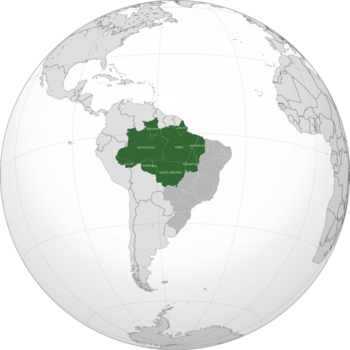Amazônia Legal facts for kids
Amazônia Legal (which means Legal Amazon in Portuguese) is the biggest special area in Brazil. It includes all nine states that are part of the Amazon basin. The Brazilian government created this area in 1948. They did this to help plan how to develop the Amazon region's economy and society.
Where is Amazônia Legal?
The official area called Amazônia Legal is huge! It covers 5,016,136.3 square kilometers. This means it makes up about 59% of Brazil's entire land. Even though it's so big, only about 24 million people live there. This is just 12.34% of Brazil's total population.
This special region includes all seven states from Brazil's North Region:
It also includes most of Mato Grosso from the Center-West Region. Plus, the western part of Maranhão in the Northeast Region is part of it.
Biomes of Amazônia Legal
Even though it's called Amazônia Legal, this area covers three different natural environments, called biomes:
- Almost all of Brazil's Amazon biome is here.
- About 37% of the Cerrado biome is included. The Cerrado is like a huge savanna.
- About 40% of the Pantanal biome is also found here. The Pantanal is one of the world's largest wetlands.
The main thing you'll notice in this region is its rich and tropical plant life. This includes vast areas of rainforest.
Amazônia Ocidental is a smaller part of this region. It includes the states of:
People of Amazônia Legal
About 24.7 million people live in Amazônia Legal. This includes more than 300,000 indigenous people. These indigenous people belong to over 170 different groups. Many traditional extractive communities also live here. These communities often get their food and resources directly from nature.
This region was one of the last parts of Brazil to be settled by people of European descent. This is because it is very remote and far away. Because of this, it still has a very low population density. This means there are not many people living in each square kilometer.
See also
 In Spanish: Amazonia Legal para niños
In Spanish: Amazonia Legal para niños
- Brazilian Institute of Environment and Renewable Natural Resources
- Brazil socio-geographic division
- Centro-Sul
- Nordeste
- Deforestation in Brazil
- Pantanal jaguar
- Regions of Brazil


